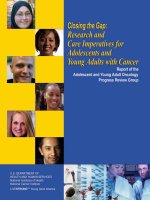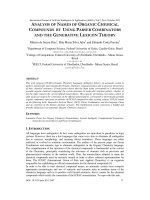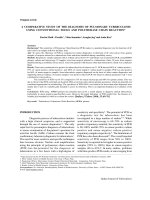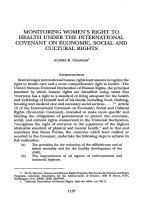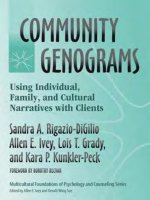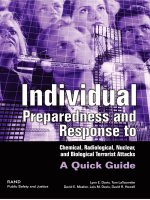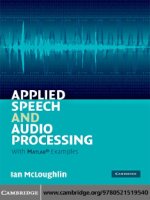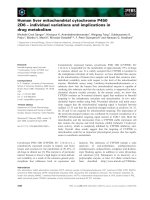Community Genograms Using Individual, Family, and Cultural Narratives with Clients doc
Bạn đang xem bản rút gọn của tài liệu. Xem và tải ngay bản đầy đủ của tài liệu tại đây (1.72 MB, 177 trang )
MULTICULTURAL FOUNDATIONS OF
PSYCHOLOGY AND COUNSELING
Series Editors: Allen E. Ivey and Derald Wing Sue
Multicultural Encounters:
Case Narratives from a Counseling Practice
Stephen Murphy-Shigematsu
Community Genograms:
Using Individual, Family, and Cultural Narratives with Clients
Sandra A. Rigazio-DiGilio, Allen E. Ivey,
Kara P. Kunkler-Peck, and Lois T. Grady
Community Genograms
Using Individual, Family, and
Cultural Narratives with Clients
SANDRA A. RIGAZIO-DIGILIO
ALLEN E. IVEY
KARA P. KUNKLER-PECK
LOIS T. GRADY
contributing author
ANTHONY J. RIGAZIO-DIGILIO
foreword by
DOROTHY S. BECVAR
Teachers College
Columbia University
New York and London
Published by Teachers College Press, 1234 Amsterdam Avenue, New York, NY 10027
Copyright © 2005 by Teachers College, Columbia University
All rights reserved. No part of this publication may be reproduced or transmitted in any
form or by any means, electronic or mechanical, including photocopy, or any information
storage and retrieval system, without permission from the publisher.
Library of Congress Cataloging-in-Publication Data
Community genograms : using individual, family, and cultural narratives with clients /
Sandra A. Rigazio-DiGilio . . . [et al.] ; foreword by Dorothy S. Becvar.
p. cm. — (Multicultural foundations of psychology and counseling)
Includes bibliographical references and index.
ISBN 0-8077-4554-5 (cloth : alk. paper) — ISBN 0-8077-4553-7 (pbk. : alk. paper)
1. Family psychotherapy—Technique. 2. Behavioral assessment—Charts,
diagrams, etc. 3. Narrative therapy. 4. Cultural psychiatry. 5. Community
psychology. I. Rigazio-DiGilio, Sandra A. II. Series.
RC488.53.C65 2004
616.89'156—dc22
2004062080
ISBN 0-8077-4553-7 (paper)
ISBN 0-8077-4554-5 (cloth)
Printed on acid-free paper
Manufactured in the United States of America
12
11
10
09
08
07
06
05
8
7
6
5
4
3
2
1
Contents
Foreword by Dorothy S. Becvar
ix
Preface: The Community Genogram
Toward a Community Spirit
Case Material
Practice Exercises
Releasing Client Creativity
Overview of the Book
A Step Closer
xi
xii
xiii
xiii
xiii
xiv
xv
xvii
Acknowledgments
1. The Community Genogram:
Understanding Clients in Their Communities
Graphic Assessment Devices: Visualizing the
Hidden Structure of Our Lives
The Community Genogram Perspective:
Capturing Individual, Relational, Family,
Community, and Cultural Relationships
Using Community Genograms Throughout the Counseling
and Therapy Process
Conclusion: The Map Is Not the Terrain
2. How to Construct and Interpret Community
Genograms: Exploring Self-in-Relation and
Family-in-Relation
Clarifying Various Definitions of Self and Family
Defining Self, Family, and the Community:
Practice Questions
A Broad View of Extended Family: Elizabeth
v
1
2
4
11
15
16
16
18
22
vi
Contents
The Separate Entity–Relational Entity Continuum
Constructing the Community Genogram
The Significance of Strengths and Positive Resources:
The Case of Jason
Practice Exercise: Identifying Individual, Family, Community,
and Cultural Strengths
Conclusion: Empowering Our Clients
3. Tapping the Liberating Qualities of Culture and
Community in Counseling and Therapy
(with Anthony J. Rigazio-DiGilio)
Identifying Cultural Influences: Practice Questions
Cultural Empathy
Going Beyond Cultural Empathy: Practice Questions
Exploring Boundaries
Exploring Power
Cultural Identity Theory: Practice Questions
The Community Genogram:
A Clinical Tool for Cultural Liberation
Conclusion: Liberate the Potential of Inherited
Cultural Legacies
4. Exploring Life Span Development with
the Community Genogram
Values and Traits: Practice Questions
Narratives and Cognitive-Emotional Responses
Major Themes Over the Life Span: Elizabeth
Using the Multicultural Cube
A Life Span Community Genogram
Tailoring the Community Genogram to Client Need
Conclusion: Interactive Assessment Methods and
Treatment Planning
5. Contextualizing the Self in Counseling
and Therapy
Setting a Safe and Enabling Context for Treatment
Using Community Genograms in Treatment:
Illustrative Dialogues
Conclusion: Client Meaning Making and the
Community Genogram
24
27
37
39
41
42
43
44
45
46
47
51
56
67
69
69
70
71
73
79
89
90
93
94
95
111
Contents
6. Using Community Genograms with Families:
A Coconstructivist Perspective
Defining Coconstructivism
Differentiating Postmodern Counseling Theories
Coconstructivist Treatment
A Portrait of Treatment: The Case of Tina and Kathy
Conclusion: Illustrating the Story Line
Epilogue
Using the Community Genogram Within a Larger
Repertoire of Clinical Practice
Conclusion: The Importance of Context
vii
112
112
113
116
120
136
137
137
139
References
141
Index
149
About the Authors and Contributor
157
Foreword
The latter decades of the twentieth century were characterized by an increase
in awareness among mental health professionals of the need for much greater
sensitivity to the larger cultural contexts in which individuals and families
live and within which the problems they experience emerge. Called to task
by both feminists and proponents of postmodernism for a view soon recognized to be far too narrow, counselors and therapists began to understand
the importance of widening the lenses through which clients were viewed.
Of crucial importance was the need to acknowledge the degree to which
factors such as gender, ethnicity, power, and privilege participated in the
creation of realities as well as in the ability to facilitate meaningful change.
Accordingly, a movement to enhance multicultural sensitivity and competence gradually evolved, culminating, in part, in various revised approaches
to the therapeutic process. One response took the form of metaframeworks
that aimed at highlighting various contextual issues and allowed for individualized responses that were sensitive to the unique characteristics of each
client system, for example, those created by Breunlin, Schwartz, and
MacKune-Karrer (1992) and Rigazio-DiGilio (1994). Similarly, several efforts have been made to expand the traditional genogram (Guerin &
Pendagast, 1976; McGoldrick, Gerson, & Shellenberger, 1999), long considered an extremely useful tool for mapping family characteristics over three
or more generations. Thus, some versions focus on religion and spirituality
(Frame, 2000), one aims at understanding money issues (Mumford & Weeks,
2003), and others seek to recognize specific cultural dimensions (Congress,
1994; Hardy & Laszloffy, 1995).
While each of the above approaches represents an important contribution to the goal of increased contextual sensitivity, the authors of Community Genograms are to be congratulated for moving this development to
another level. As a function of the potential of the community genogram to
portray the issues of importance to each client and to do so in a manner
appropriate for that client, counselors and therapists are being provided with
a tool that may enhance their ability to understand the particular contextual
characteristics impinging upon those with whom they are working. What is
ix
x
Foreword
more, given that the community genogram is process oriented, it may be
incorporated easily into the work of mental health professionals having widely
differing theoretical orientations.
In this very pragmatic book, the community genogram is presented and
illustrated in a manner consistent with a coconstructivist perspective. As
readers are guided to a place of understanding, they are likely to be intrigued
by the ways in which use of the community genogram may allow clients’
stories to be viewed and reviewed at various points in time, both past and
present, and in various ways, with the opportunity then to expand these stories into more comfortable futures. Aspects of these narratives that otherwise might have been overlooked are allowed to emerge as both figure and
ground are considered, utilizing the client’s perspective as organizing framework. What may be even more significant is that the authors have provided
an avenue for creative expression should that be desired, while at the same
time offering a standard format that may be adapted by clients to fit their
situations should the former option seem too daunting. In either case, the
community genogram allows for an operationalization of the postmodern
emphasis on shared expertise as clients are encouraged to depict and narrate
their life stories in ways that are most meaningful to them. Given such a
combination of distinctive and unique characteristics, this book truly represents a noteworthy accomplishment.
DOROTHY S. BECVAR, ph.d.
Preface:
The Community Genogram
The community genogram is an assessment and treatment strategy that facilitates the understanding of individuals and families in social and historical context. We hope you will find that the community genogram provides a
rich source of data, enabling you and your clients to understand how concerns, problems, and issues develop over time and across contexts.
Equally important, you will find the community genogram an invaluable source of client strengths. We argue that counseling and therapy, whether
individual, family, or group centered, tend to focus predominantly on client
difficulty and so-called pathology. Lasting change, however, builds on client, family, and community strength and capacity. As such, the various questioning strategies associated with constructing community genograms can
guide you and your clients to maintain a focus on positive individual, family, and community strengths and resources.
Helping clients realize the many sources of strength they can access
within themselves and within their wider community needs to be a part of
every counseling or group session (Ivey, Gluckstern, & Ivey, 1992; Ivey,
Pedersen, & Ivey, 2001). Community genogram approaches emphasize
strengths within the positive orientation of narrative therapy. Clients learn
to broaden the lens they use to rewrite and story their lives in stronger, more
constructive, and more beneficial ways. We say, “If you cannot find something right about your client, then refer!”
The community genogram helps us, as clinicians, to see the individual
or family client as part of a larger temporal and contextual community.
This idea is akin to an African worldview, where “the idea of communal
interconnection . . . not only promotes and supports the idea of persons
within community, but also maintains that the vantage point grounded in
community creates a more holistic conception of the person as community. . . . [In this regard] the sickness of the individual [or family] is symptomatic of a deeper communal malaise” (Ogbonnaya, 1994, p. 81).
xi
xii
Preface
“To deal with the symptom is at most a temporary benefit; real healing
requires the establishment of right relationship [between persons and community].” Therefore, “when dealing with any ‘pathology’ the cultural dimensions influencing the individual’s [or family’s] concept of illness and
behavior responses to crises should be taken seriously so that sociological
and cultural ideas which play a significant role in the development and
interaction of the [individual or collective] personality can become part of
the therapeutic process.” Finally, “in the communitarian process of healing, one cannot be ‘saved’ as an individual. . . . To heal the one, the many
must also be healed or the one continues to be sick and to create sickness”
(Ogbonnaya, 1994, p. 86).
TOWARD A COMMUNITY SPIRIT
One reason for writing this book was our desire to reinforce the value of community. In a time when many of us are reporting the lack of community in our
busy lives, we need methods to help identify the community influences that
can combine to improve or impede our pursuit of happiness. The activities
depicted in this book demonstrate how to infuse these vital community influences into the counseling process. Often our clients are unaware of the power
of these influences and how, if at all, they may make changes in their social
environment. The focus of this book is to map these forces, whether in the
past, the present or the future, to increase the levels of support our clients can
use to initiate and sustain the changes they wish to create in their lives.
Bringing in community issues can often overwhelm both client and
therapist. It is often easier to remain focused on the intrapersonal thoughts,
feelings, and beliefs our clients bring to treatment. When large segments of
the community are brought into treatment it may be difficult to retain a
focused exploration of these broad, all-encompassing aspects of life. The
community genogram allows our clients to determine which slices of the
community will be salient and provides clear parameters to maintain
the focus of this discussion.
It is through the analysis of community issues that our clients can reap
two benefits. First, they may understand the community issues that contributed to their current situation. In this way, clients may feel empowered if
they realize the external forces that colluded to oppress and minimize personal options available to them. Second, they may realize methods of altering community forces for themselves and others. It is this second benefit that
may result in creating more optimizing environments for our clients and their
wider communities. Certainly, many more people will benefit from changes
in social services and policies that promote mental health for all. If we per-
Preface
xiii
sist in helping one client at a time, we will never achieve the kind of social
environments that honor individual differences and celebrate the interconnectedness of all community members.
CASE MATERIAL
Throughout this book we have liberally used interviews with clinical and
nonclinical individuals, couples, and families to illustrate how the community genogram can be used to help clients analyze and act upon external influences that have affected their lives. The cases and interviews demonstrate
a wide range of cultures, age groups, and clinical and lifespan issues. By
examining the variety of questioning strategies contained in these examples,
clinicians can derive methods of coconstructing community genograms. All
personal identifying information has been changed to protect the privacy of
those who have contributed to this book.
The examples offer a wide range of scenarios and variations of the community genogram. In the clinical cases, the approach is similar in that each
intervention is aimed at empowering clients to understand and, eventually,
influence the community forces that are operating in their immediate life
space. Of course, other therapeutic methods aimed at more intrapersonal and
intrafamilial issues were used, but these are not the focus of this book.
PRACTICE EXERCISES
In Chapters 2–4, practice exercises and practice questions are offered for you
to use on yourself or to use with clients. The exercises and questions are
provided to help create sufficient knowledge for clinicians to adapt the community genogram to their practice. We strongly urge you to fully participate
in the exercises to experience the power of the community genogram and to
use this knowledge to help clients sort through the many memories that are
generated by these techniques. Feel free to alter these methods and questions
to fit both the needs of your clientele and your ability to use visual, interactive devices in counseling and therapy.
RELEASING CLIENT CREATIVITY
We have found the creativity of our clients to be limitless, and we often learn
new approaches and deeper questions to pursue as clients add their own
insight and artistic preferences to the construction of their community
xiv
Preface
genogram. We have tried to communicate the creativity and enthusiasm our
clients have expressed when using a simple tool to unlock complex issues
like community influences, supports, and obstacles. It is up to mental health
professionals to help make the invisible forces influencing their clients visible. The community genogram is one tool, and we hope you and your clients find it as enjoyable and illuminating as our clients have.
Throughout the book, various examples of how clients have used their
creativity and expressive skills to illustrate the complexities of community
influences are presented. The variations demonstrate the unique configuration a community genogram can take to help clients isolate and explore contextual elements of their issues. We begin with a wide distribution of
community genogram types in the early chapters of the book. In Chapter 3
a particular type of community genogram format, the star diagram, is introduced and then elaborated on in subsequent chapters. This decision was made
for educative reasons and is not meant to limit your own or your client’s creativity in depicting relevant contextual factors and interactions. Our central
focus is to demonstrate how contextual dimensions contribute to the definition of and solution to clients’ presenting issues, and this book is meant to
be only a guide for designing activities and strategies that help clients assess
the power of their community and devise ways to create change at both a
personal and a community level.
OVERVIEW OF THE BOOK
It is impossible to include all the ways communities interact with individuals and families in one book. We have organized this book into six chapters
that provide windows on how to relate contextual and cultural dimensions
to personal and familial narratives. Chapter 1 provides an overview of the
community genogram process and situates this tool within the domain of
graphic assessment devices. It presents a broad overview and anchors our
work within an ecosystemic framework. In Chapter 2 the specifics of how
to construct community genograms is provided. We offer a multidimensional
definition of self and family, and use this as a basis for introducing contextual issues into the treatment process. Chapter 3 offers a culturally informed
perspective of human interaction and specifically focuses on the issues of
boundaries and power. Both of these aspects are crucial in understanding
how community and contextual variables influence clients’ identity and the
types of solutions they seek. Chapter 4 explores issues across the life span.
Using a broad definition of the types of issues clients may present, we examine the potential differences persons may experience as they progress through
life. In Chapter 5 a detailed analysis of one session is provided. Our goal
Preface
xv
here is to demonstrate the nuances of using a community genogram to explore issues of identity, power, and oppression. Chapter 6 provides a similar
analysis, this time using a relational system, and shows the ways community
genograms can assist families to understand the history of intergenerational
dynamics and to influence the future unfolding of these dynamics. The epilogue concludes this work with suggestions on how to continue to use the
community genogram in the service of client assessment, treatment, and
evaluation. Each chapter offers a unique slice of how the community
genogram can be used. When taken as a whole, the book creates a broad
view that will assist clinicians to use the tools as they see fit in the particulars of their own practice.
A STEP CLOSER
By moving toward the integration of culture and counseling approaches, we
hope this book helps move the field one step closer toward truly treating all
clients with respect for the numerous contextual forces that shape client functioning. Rather than continuing the trend to blame the victims, the approach
advocated in this book asks clinicians to search beyond the client’s intrapsychic and interpersonal relationships to consider how community and intergenerational factors might figure in the manifestation and maintenance of
distressed feelings, thoughts, and behavior. We do not believe that all client
issues are initiated in wider contexts, but we do believe that the reaction of
the wider community can ameliorate or exacerbate client issues. By identifying and linking community-based assets, our clients can realize new options
for growth and change. This is the goal of our book: to help clients find relational, community, and cultural assets to enhance their lives.
Acknowledgments
Sandra respectfully acknowledges the influence and guidance of Allen Ivey
in her training, career, and life. I am honored to collaborate with him on a
project that brings culture, context, and multiperspective thought to the
foreground of the therapeutic process. I also wish to thank Lois and Kara
for the vision and clarity they brought to this project, and the individuals
and families whose community genograms provide the real life translation
of this work to practice. The professionals at Teachers College Press are to
be commended for their assistance as this book came into being, especially
the direction and support of Carol Collins. Finally, I wish to acknowledge
my mother and father, in memory, and Anthony, Elizabeth, Nicholas, and
Nonni, with love.
Allen gives special thanks to Mary Bradford Ivey for her constant support,
editing, and encouragement. It has been a delight to know and work with
Sandra Rigazio-DiGilio these past years and learn from and with her.
Kara Kunkler-Peck and Lois Grady have been special stars of competence,
and I feel lucky to be in partnership with them.
Kara expresses her gratitude to her coauthors for their dedication to the
book and the ideas contained within. It has been a tremendous honor to
have an opportunity to work with such a committed group of professionals. I would like to extend my deepest thanks to all my family members
who have provided inspiration, encouragement, and support.
Lois gratefully acknowledges the support and mentorship of Allen Ivey
during and after her pursuit of her doctorate. Doris Shallcross shepherded
me through this doctorate. Elaine Anderson has been and is my special
friend and constant support. Sandra Rigazio-DiGilio has been a fun and
wonderful coauthor. Lyle Perkins inspired and mentored me for my
Ceramic degree. Don Wise has been and is a teacher, mentor, coauthor,
and colleague in my love of geology. I am also appreciative of the tolerance, continuing support, and encouragement for all the various interests
in my life from my husband and children.
xvii
CHAPTER 1
The Community Genogram:
Understanding Clients in
Their Communities
This book introduces the community genogram as a therapeutic tool that can
be used as both an interactive assessment and intervention strategy with individuals and families. The objective of this book is to consider clients as individuals-in-relation and as families-in-relation rather than as isolated entities.
The community genogram emphasizes individual, relational, contextual, and
cultural dimensions. It enables clinicians to see, in visual form, clients’ perceived social networks of the past and present, as well as their anticipated future
networks. The primary value of this strategy is that it facilitates the identification and activation of contextual and community dynamics and resources often
times beyond the awareness of the clinician and client.
Three major points are raised in this chapter:
• The definition of the community genogram
• The relationship of the community genogram to other graphic
assessment tools
• How to use the community genogram within the counseling
process
The community genogram offers a natural, yet systematic, way to examine the impact of significant people, situations, and experiences that have
affected clients and their sense of themselves. Community genograms are
highly versatile and free up clients to select different time spans, contexts,
and sets of people to explore at multiple points throughout the therapeutic
relationship. There are endless modifications that can be made to the basic
community genogram format and questioning strategies in order to integrate
this device across all treatment modalities: individual, family, network, and
consultation. Although certain elements of how community genograms are
constructed and used will be common across all clients, how particular clients choose to represent important aspects of their lives will be more influenced by the particular constellation of issues they bring to treatment and
by their own creative capacities and experiences.
1
2
Community Genograms
The community genogram is a graphic assessment device used to surface
and explore family, social, and cultural forces that influence individual and
family development. Its aim is to help clients examine individual or family issues within their full contextual background. It focuses on important social
(family, peer, and coworker) and community (church, school, neighborhood,
municipal services) resources that may contribute to the client’s problem and
play a role in possible solutions. It is a versatile tool that can be used to capture different perspectives from family members and different time spans.
The community genogram is derived from two concepts. First, the term
genogram is used to reinforce the importance of family legacies on the physical
and psychological development of individuals and families. In traditional
models of counseling and therapy, these legacies are often only examined in
a decontextualized fashion. To place those legacies within the wider dynamic
field generated by interaction with peer, ethnic, religious, and professional
networks, the second concept of community setting is added. Through the
community genogram, clients can depict the representations of key periods
in their life that can support and deepen the therapeutic conversation.
Different from the more standardized techniques of family genograms
(i.e., McGoldrick, Gerson, & Shellenberger, 1999), the community-oriented
approach encourages clients to develop a broad image of self, family, and
community in a way that is most helpful to them. As such, many variations
on community genograms are possible with examples presented throughout
this book.
GRAPHIC ASSESSMENT DEVICES:
VISUALIZING THE HIDDEN STRUCTURE OF OUR LIVES
For several decades, graphically representing client experience has been acknowledged as an invaluable therapeutic tool (see Guerin & Pendagast, 1976;
L’Abate & Bagarozzi, 1993; McGoldrick et al., 1999; Thomlison, 2002). Such
strategies assist clinicians and clients alike to describe and reflect upon issues such as individual development and family dynamics.
The Family Genogram
The most common graphic assessment tool, the family genogram (McGoldrick et al., 1999), has been used in individual, family, group, and medical
settings. The use of this device in gathering pertinent information in individual and family therapy has been a standard practice for many years.
The family genogram offers a comprehensive way to gather general information such as the names of significant family members and the dates of
The Community Genogram
3
significant family events, like marriages, births, divorces, and deaths. Additionally, the way family genograms are organized can uncover valuable clinical information about issues such as family alliances, coalitions, and triangles;
family legacies; and repeating family themes and scripts. Particularly useful
for bringing out latent and unrecognized intergenerational family patterns,
the family genogram demonstrates the value of systematically representing
family data in a way that can be referred to at a glance by clinicians, clients,
supervisors, and other human service professionals (see Becvar & Becvar,
2003: Dunn & Levitt, 2000; Frame, 2000; Gladding, 2002; Green, 2003;
Green, 1999; Worden, 2003).
The Cultural Genogram
As more attention is given to ensuring the cultural competence of counselors
and therapists, graphic assessment devices have been developed as concrete
tools to assist in this process. The cultural genogram (Hardy & Laszloffy,
1995) is one of the more useful tools used for this purpose. The goal, as described by Hardy and Laszloffy, is to “promote cultural awareness and sensitivity by helping trainees to understand their cultural identities” (p. 228).
This graphic organizer is used to (1) clarify the influence of culture on a family
system; (2) identify significant groups that contribute to the formation of a
cultural identity; (3) facilitate discussion that uncovers and challenges culturally based assumptions and stereotypes and unresolved culturally based
conflicts; and (4) assist counselor and therapy students and supervisees to
understand how their own cultural identities affect their therapeutic style and
effectiveness (Hardy & Laszloffy, 1995).
Although the cultural genogram was conceived as a training tool, it also
has clinical applicability (Congress, 1994). For example, it offers a framework that could be used to assist cross-cultural families whose symptoms
manifest their attempt to blend or balance cultural issues.
The Eco-map
The eco-map is a paper-and-pencil and computer-generated simulation that
graphically illustrates the relationships between individual and family clients
within their environmental contexts (Hartman, 1978). The eco-map portrays
the major systems, such as health care, social services, school, work, friends,
and extended family members, that directly impact on the life space of the
client. Lines and arrows connecting the client with these other systems represent various levels of conflict and support. Clinicians have used the eco-map
as a tool for activating the client’s participation in determining assessment,
planning, and intervention strategies over the course of treatment (Gladding,
4
Community Genograms
2002; Thomlison, 2002). Further, the eco-map has proved to be useful in
helping clients realize the environmental stressors impacting on their situations and to identify alternative relationships and resources that might be
helpful (Hanson & Boyd, 1996).
Other Graphic Organizers
Other graphic organizers also have been employed to capture cultural information about families (e.g., Thomlison, 2002). Such tools help to illuminate
the powerful dynamics of cultural forces operating on the individual, family, or group.
In addition, visual tools have been used to focus on individual and family histories (e.g., Duhl, 1981); family structure, development, and problem
solving (e.g., Meyerstein, 1979); gender role developmental histories (e.g.,
Green, 2003); recollections of one’s family-of-origin (e.g., Coopersmith,
1980); individual and family self-perceptions (e.g., Thomlison, 2002); and
sources of personal validation (e.g., Ivey, D’Andrea, Ivey, & Simek-Morgan,
2002). Such tools highlight individual and family contextual and temporal
factors as these might affect issues promoting treatment.
All of these techniques are methods to pictorially represent the significant interpersonal and intrapsychic phenomena that help shape the ongoing
experiences, interpretations, decisions, and actions of clients. Separately, these
tools have proven their clinical utility. However, these graphic assessment
devices do not explicitly address the issues of self-in-context or family-incontext and do not capture the larger contexts that influence human and
systems development over time.
THE COMMUNITY GENOGRAM PERSPECTIVE:
CAPTURING INDIVIDUAL, RELATIONAL, FAMILY,
COMMUNITY, AND CULTURAL RELATIONSHIPS
The community genogram synthesizes many intra- and interpersonal factors
in an organized and simple to use format. As an interactive assessment device, the community genogram captures holistically—in one representation—
many of the variables targeted by other graphic assessment devices. Further,
although other devices are predominantly used at the beginning of treatment
for assessment and treatment-planning purposes, the community genogram
can be referred to, modified, and enhanced throughout counseling and
therapy. Because the community genogram is conceptually different from
other graphic assessment methods, it is important to review the perspectives
that led to its construction and use.
The Community Genogram
5
Historically, in northern European and U.S. cultures, individuals and families have tended to be viewed as isolated entities. Intrapsychic and intrafamilial
dynamics were the primary focuses of counseling and therapy. Rarely were
the interactions between clients and wider social contexts considered. Feminist
theorists and therapists (see Goldner, 1993; Hare-Mustin, 1978; Luepnitz,
1988; Whipple, 1999; Williams & Wittig, 1997) raised the concern that classical
theories of treatment, whether individually oriented or family focused, did not
attend to the cultural factors that contributed to client distress.
Paralleling feminist critiques, multiculturalists also criticized traditional
counseling models for the lack of respect shown to ethnic and racial sensitivities (see, Cheatham, 1990; D’Andrea & Daniels, 2001; Falicov, 1988;
Hardy, 1990; Ibrahim, 1985; Pedersen, 1991). All clients, in traditional
models of treatment, were treated the same, regardless of their age, cultural
background, and gender. Today, clinicians recognize the need to provide
culturally responsive treatment in a way that will not perpetuate oppression
from wider social forces.
Individuals and families do not develop alone, as pawns of the environment. Nor do they develop independent of their external world. The community genogram is based on an ecosystemic perspective (Auerswald, 1983),
which integrates individual and systems theories to consider the holistic development of clients. It is our opinion that the individual develops within a
family, within a community setting, and within a societal and cultural milieu. Thus, it is the transaction between individual, family, and environment
that is the dynamic force of development and adaptation (see Axelson, 1999;
Harland, 1987; Ivey, Gonỗalves, & Ivey, 1989; Vygotsky, 1934/1986).
According to Minuchin (1974), the family serves two basic functions:
(1) to provide for the psychosocial needs of their members and (2) to balance the demands of the broader culture with their own needs and cultural
mores. Similarly, we posit that families provide a primal socialization matrix for individuals to develop, and as individuals develop, the family’s boundaries extend to include wider contexts that influence different aspects of each
individual, each relationship, and the system as a whole. Simultaneously,
families are also subsystems of larger social units, and, as such, they rely on
their developmental and contextual histories to give meaning to and operate
within larger social entities. Figure 1.1 demonstrates one ecosystemic method
to conceptualize the mediating role of the family across time. The dynamics
within and among the levels are conceptualized as four concentric circles
specifying that cultural, societal, community, and family dynamics are operating within the relationship development of family members. The significant effects of these dynamics must be accounted for in a culturally responsive,
non-oppressive approach to counseling and therapy. As demonstrated within
the family system level of the diagram, each interacting individual carries
6
Community Genograms
FIGURE 1.1. The Family as the Mediating Context for Human and Systemic
Development
elements of all four levels as they naturally work to evolve personal meaning about themselves and others through the lens of the family context. For
this reason, we consider the family system as the primary, but not exclusive,
domain for the creation of the initial impressions of our sense of self and
self-in-relation that we carry with us, to some extent, throughout our lives.
This holistic perspective permits clinicians and clients to access numerous sources of personal and collective strength that can be used to reevaluate the past and effect change in current life tasks and future adaptation. It
can widen the analytic lens used by clinicians and clients so that they might
perceive and target major stressors and strengths, not only as these are situated in individuals and families, but also as these are located in communities, prevailing cultural contexts, and the interactions that occur among all
four domains. Personal, interpersonal, and interactive resources residing
within these multiple contexts can be identified and marshaled to facilitate
therapeutic growth.
Notice that the element of time is represented in Figure 1.1. Our understanding of self and self-in-relation evolves over time, through a cultural
exchange process among individuals, families, significant others, and resonating community and cultural constructions. Sociohistorical conditions over
